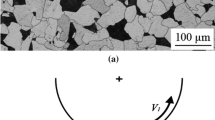Abstract
Caliber rolling at the recrystallization temperatures of ferrite is a new process that was developed to fabricate an ultrafine-grained microstructure for low-carbon steels. In the present investigation, the electron backscattered diffraction (EBSD) measurement was carried out to characterize thoroughly the texture and substructural features in two caliber-rolled low-carbon steels, with special attention on the effects of a phosphorus addition to the steel and the annealing treatment after rolling. Finer ferrite grains appeared in the phosphorus-added steel under the same rolling condition. The phosphorus addition caused also the stronger <110>//rolling direction (RD) fiber texture in the caliber-rolled steel bars and, hence, showed a larger average Taylor factor than the steel without phosphorus. Microband features within the ultrafine ferrite grains were characterized with both transmission electron microscopy (TEM) observation and orientation-imaging micrograph (OIM) analysis. Nearly half of the low-angle boundaries, whose kernel average misorientation was larger than 0.8 deg, were found to have the planar character and were specifically parallel to the {110} or {112} planes. In the as-rolled condition, the total volume fraction of the low-angle boundaries was 0.3 and 0.23 in the steels with and without a phosphorus addition, respectively. More {112}-type planar boundaries were observed than the {110} type boundaries in both steels. Annealing treatment increased the volume fraction and changed the type of the low-angle boundaries in both steels. Using the model proposed by Peeters et al., the critical resolved shear stress (CRSS) of the 110 and 112 slip systems was calculated by considering the contributions of both the randomly distributed dislocations and the oriented planar boundaries. We concluded that the contribution of the planar low-angle boundaries to the total CRSS was less than 2 pct. The texture features and dislocation structure in the ultrafine-grained steels influenced the mechanical behavior to some extent, in addition to the refined ferrite grains. Phosphorus added to the steels showed a larger influence on the formation of texture and the retained dislocation structure, than that on the grain refinement in the caliber-rolling process.
Similar content being viewed by others
References
F.B. Pickering: Physical Metallurgy and the Design of Steels, Applied Science Publisher, London, 1978, pp. 20–35.
T. Inoue, S. Torizuka, and K. Nagai: Mater. Sci. Technol., 2001, vol. 17, pp. 1329–38.
K. Nagai: J. Mater. Proc. Technol., 2001, vol. 5187, pp. 1–4.
T. Hanamura, T. Yamashita, O. Umezawa, S. Torizuka, and K. Nagai: CAMP-ISIJ, 2001, vol. 14, p. 669.
M. Heimaier, M. Nganbe, B. Beckers, H.-G. Brokmeier, R. Tamm, C.-G. Oertel, and W. Skrotzki: Mater. Sci. Eng., 2001, vols. A319–A321, pp. 290–93.
U.F. Kocks: Metall. Trans., 1970, vol. 1, pp. 1121–43.
A.B. Lopes, E.F. Rauch, and J.J. Gracio: Acta Metall. Mater., 1999, vol. 47, pp. 859–66.
B. Orlans-Joliet, J.H. Driver, and F. Montheiliet: Acta Metall. Mater., 1990, vol. 38, pp. 581–94.
B. Peeters, M. Seefeldt, P. Van Houtte, and E. Aernoudt: Scripta Mater., 2001, vol. 45, pp. 1349–56.
B. Peeters, M. Seefeldt, C. Teodosiu, S.R. Kalidindi, P. Van Houtte, and E. Aernoudt: Acta Metall. Mater., 2001, vol. 49, pp. 1607–19.
B. Peeters, B. Bacroix, C. Teodosiu, P. Van Houtte, and E. Aernoudt: Acta Metall. Mater., 2001, vol. 49, pp. 1621–32.
X. Huang and D.J. Jenson: in Electron Backscattering Diffraction in Material Science, A.J. Schwartz, M. Kumar, and B.L. Adams, eds., Kluwer Academic/Plenum Publishers, New York, 2000, pp. 265–76.
T.A. Bloom, D.R. Fosnacht, and D.M. Haezebrouck: Iron Steelmaker, 1990, No. 9, pp. 35–61.
D.G. Brandon: Acta Metall. Mater., 1966, vol. 14, pp. 1479–84.
F. Yin, T. Hanamura, O. Umezawa, and K. Nagai: Mater. Sci. Eng., 2003, vol. A354, pp. 31–39.
M.F. Ashby: Acta Metall., 1966, vol. 14, pp. 679–85.
H. Hu: Texture Cryst. Solids, 1980, vol. 4, pp. 13–40.
W.B. Hutchinson: Int. Met. Rev., 1984, vol. 29, pp. 26–42.
D. Breuer, P. Klimanek, U. Muhle, and U. Martin: Z. Metallkd., 1997, vol. 88, pp. 680–686.
Author information
Authors and Affiliations
Rights and permissions
About this article
Cite this article
Yin, F., Hanamura, T., Inoue, T. et al. Fiber texture and substructural features in the caliber-rolled low-carbon steels. Metall Mater Trans A 35, 665–677 (2004). https://doi.org/10.1007/s11661-004-0378-z
Received:
Issue Date:
DOI: https://doi.org/10.1007/s11661-004-0378-z




